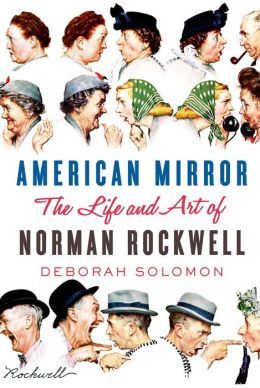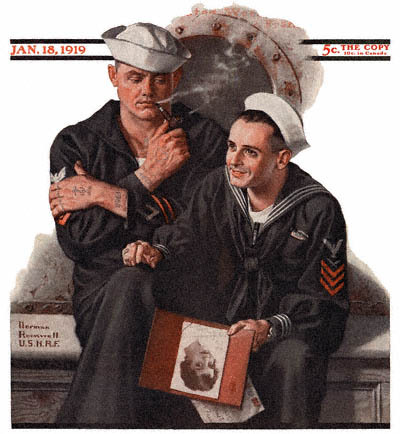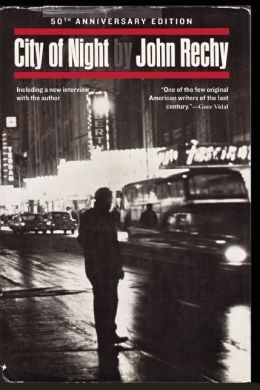AMERICAN MIRROR: THE LIFE AND ART OF NORMAN ROCKWELL
CITY OF NIGHT
HAPPINESS: A VERY SHORT INTRODUCTION
AMERICAN MIRROR: THE LIFE AND ART OF NORMAN ROCKWELL
BY DEBORAH SOLOMON
$28; Farrar, Straus and Giroux
This major look at the work of illustrator Norman Rockwell is a sober, serious, thoughtful analysis of a significant artist and how his life influenced his work. But that doesn't mean a review of the book need maintain such high standards. Whenever anyone asked what I was reading, I said "a biography of Norman Rockwell" and immediately added, "It turns out he was probably gay, even if Rockwell himself didn't quite realize it." Oh really, they perked up?
Author and critic Deborah Solomon's book doesn't belabor the point or make too much of it, or to be more precise doesn't turn it into gossip. Like me, she doesn't find the idea shocking nor downplay what it might mean. But the man who symbolized American heartland values spent decades in therapy and rarely attended religious services? Had three marriages that were almost comical in their abruptness? (Rockwell didn't have marriages of convenience so much as convenient marriages.) Two of them at least were unhappy and the third came at such a late stage that it was far more about companionship than anything else, if indeed the others were anything more either.
Suddenly, the details pile up. A close look at some of Rockwell's work reveals an unconscious homoerotic subtext. He had intense male friendships and personal diaries reinforce this idea. He focused again and again on adolescent boys in his paintings and often dropped the teens without a second glance once the models he used became too old to interest him anymore.
Does it matter? Of course it matters, just as the gender or the race of an artist matters. It is fundamental to who they are as a person and informs their art on many levels, whether or not that artist address gender or race or sexuality in their work. And of course it doesn't matter, really, though when writing a biography it's certainly essential to grasp such a major possibility, even if the person themselves remained blinkered to it. Did Rockwell ever act on what seems to be his natural inclination? There's no smoking gun and it seems doubtful; his was an arrested adolescence, enamored of boyhood and extended to his diet: Rockwell hated vegetables and liked nothing more than a scoop of Breyer's vanilla ice cream for dessert. Still the possibility of a thwarted nature shadows his life and puts his rather sad private existence in a new light.
Rockwell is seen as embodying the American family, but as Solomon points out, the American family as a unit is almost never portrayed in his work. It's the community, the civic family that dominates and Rockwell expressed an urge to... not blindly conform as was so often assumed during his lifetime but to belong, to participate, to fit in and achieve normalcy, which is a very different desire from conforming. This takes on a more plaintive aspect if one believes that Rockwell couldn't even be comfortable in his own skin. Happily, any suppressed desires didn't manifest themselves in inappropriate conduct with the countless boys he worked with over the years -- always a possibility when anyone of any orientation tamps down something as primal as sexual desire. Sadly, Rockwell himself would probably be astonished and confused and embarrassed by everything I just blithely speculated about him. He belonged to an era and a mindset where such things were simply unimaginable.
Solomon's work is far more all-encompassing than the passages I just focused on, though her clear analysis of his artwork proved very convincing to me. (And not just in obvious examples like this one.)
Indeed, Solomon's biography is fascinating and empathetic throughout, beginning with the artistic impulses that arose with his ancestors to a childhood overshadowed by his handsome, athletic older brother. He came of age during a golden period for illustrators, when they would work on illustrating classic works for publishers, provide excellent artwork for magazines before the heyday of the photograph and of course make money in advertising. Rockwell befriended the great Leyendecker brothers, who lived spinster-like in a mansion in New Rochelle. J.C. Leyendecker created the iconic Arrow Collar Man and took the model most associated with that campaign for his lifelong love. Rockwell would always value their friendship and mentoring during his early years, paying it back in loyalty over time.
And here I'm getting ahead of myself and the most admirable fact about American Mirror. Rockwell was just 22 when he first created a cover for the Saturday Evening Post and he'd already had work appear in exhibitions and been written about as a rising talent before befriending the Leyendeckers. He enjoyed essentially unbroken commercial success his entire life. Yes, he had the usual travails of life -- deaths, divorce, distant relations with some of his children -- but it's basically the story of a commercially successful man who worked at his task for decades while enjoying increasing popular support and seemingly unbothered by the lack of critical appreciation.
Despite this smooth sailing, Solomon creates a compelling book out of what is a not terribly compelling life. She accomplishes this by focusing on his art; how it was accomplished, how he grew and how his work is far more interesting than a casual glance that gets the "joke" or story of his one-panel tales might suggest. The descriptions of how he used props and varied details to create the tableaux of his covers are fascinating. Rockwell was very forthcoming about how he'd take live models, pose them and then take pictures so he could work at his leisure to get the specifics just right. This was seen as cheating somehow -- shouldn't real artists not have to use photography to do a painting? But of course now we know how often the masters used similar techniques of mirroring real props to achieve their effects and Rockwell can take his place among artists who use technology not to cut corners but to refine their craft.
His success was so broad and middle-brow, it may take another generation or two for all the hype both for and against Rockwell to calm down and let his work be judged strictly on its merit. Surely the greatest blow is that so much of it has apparently been lost, one of the side effects of being a "mere" illustrator whose cover art displayed on magazines went into the trash after that week's issue had been read. Few thought to treat the originals with any more care. Thanks to Solomon, we can see how intriguing and complex that work truly was and begin to appreciate it not just for its humor or the hidden clues it reveals about its author but for their unquestioned skill and layers of meaning that say more about America than perhaps even Rockwell realized at the time.
CITY OF NIGHT 50TH ANNIVERSARY EDITION
BY JOHN RECHY
$16; Grove Press
In the early 1960s, Norman Rockwell had married his third and final wife and was working on his Civil Rights masterpiece The Problem We All Live With. I'd be astonished to hear he was even aware of the publication of John Rechy's City Of Night in 1963. A novel about a "youngman" -- a young male hustler traveling the country -- that was written in a stream of consciousness style that disparaged middle class values and apostrophes with equal abandon? It's hard to imagine anything further from his experience than the seedy, desperate world depicted by Rechy, who scandalized and intrigued the media by continuing to hustle even after he was a published author.
Rechy wrote other books dealing with hustlers and the coming apocalypse that was AIDS but it's his memoir/novel about sex workers as they're known today that remains his legacy. It falls in the Beat category though Rechy didn't know the Beats at the time and wasn't influenced by them. Still, it's a clear companion piece to On The Road and can now be read as a novel rather than for some in days gone by as a how-to guide for anyone new to a big city and short on cash.
It's been praised by the likes of Gore Vidal and James Baldwin in the past and now continues to reap praise from Michael Cunningham, Edmund White and others. It will appeal to those who like the bleak landscapes of books like Last Exit To Brooklyn and Naked Lunch. This new edition contains a letter from Baldwin praising the book, a 1984 introduction by the author, a new afterword by the author, facsimiles of galley pages and an interview from Vice magazine by Steve Lafreniere. If only the cover had been illustrated by Rockwell.
HAPPINESS: A VERY SHORT INTRODUCTION
BY DANIEL M. HAYBRON
$11.95; Oxford University Press
One can imagine John Rechy or Norman Rockwell perusing and benefiting from Happiness: A Very Short Introduction. The latest in the welcome and erudite "A Very Short Introduction" series, this one is written by Daniel M. Haybron, a professor of philosophy at St. Louis University. In a very brisk 147 pages (the book is in a small, portable format), Haybron introduces the idea of happiness, suggests we should be the happiest people in history (we live longer, are healthier and wealthier by every standard, are better educated, can see more of the world, etc. etc.) and then explains why this is not so and why.
You're led gently by the hand and before you know it grappling with some interesting philosophical concepts via concrete and understandable examples that are explained lucidly even for novices like me who don't know a Schopenhauer from a Spinoza. Undoubtedly, Rockwell would have just returned to his painting and Rechy to his clients or companions, but they'd at least have food for thought. You will too.
BOOKS I'VE READ SO FAR IN 2013
1. A Natural History Of Dragons by Marie Brennan ***/
2. Mother's Milk by Edward St. Aubyn *** 1/2
3. Junius And Albert's Adventures In The Confederacy: A Civil War Odyssey by Peter Carlson *** 1/2
4. Why Priests? by Garry Wills ** 1/2
5. The Black Country by Alex Grecian ***
6. Toms River by Dan Fagin ***/
7. Breakfast At Tiffany's by Truman Capote *** 1/2
8. The Art Of Hearing Heartbeats by Jan-Phillip Sendker ** 1/2
9. London Falling by Paul Cornell ***
10. Transatlantic by Colum McCann *** 1/2
11. Matilda by Roald Dahl **
12. Maggot Moon by Sally Gardner **
13. Great North Road by Peter F. Hamilton *** 1/2
14. A Dual Inheritance by Joanna Hershon *** 1/2
15. Little Green by Walter Mosley *** 1/2
16. Masqueraders by Georgette Hayer *** 1/2
17. Life After Life by Kate Atkinson ***
18. The Vatican Diaries by John Thavis ***
19. Island Of Bones by Imogen Robertson ***
20. Circle Of Shadows by Imogen Robertson ***
21. Queen Of The Air by Dean Jensen *** 1/2
22. His Majesty's Hope by Susan Elia MacNeal ** 1/2
23. The War Below by James Scott ** 1/2
24. Bad Monkey by Carl Hiaasen ***
25. The Lowland by Jhumpa Lahiri ****
26. The Unwinding by George Packer ****
27. Winger by Andrew Smith *** 1/2
28. Hickory by Palmer Brown ***
29. Soulless by Gail Corriger ***
30. Revolutionary Summer by Joseph Ellis ***
31. The Longest Way Home by Andrew McCarthy *** 1/2
32. The Cleaner Of Chartres by Sally Vickers ***
33. The Man Who Was Poe by Avi ** 1/2
34. Openly Straight by Bill Konigsberg ** 1/2
35. The Bone Season by Samantha Shannon *
36. Blood Of Tyrants by Naomi Novik *** 1/2
37. White Butterfly by Walter Mosley *** 1/2
38. Black Betty by Walter Mosley *** 1/2
39. The Mouse With The Question Mark Tail by Richard Peck ** 1/2
40. Proxy by Alex London ***
41. Delilah Dirk and the Turkish Lieutenant by Tony Cliff ** 1/2
42. A Monster Calls by Patrick Ness *** 1/2
43. More Than This by Patrick Ness *** 1/2
44. Dissident Gardens by Jonathan Lethem ***
45. The Good Soldiers by David Finkel ****
46. Fallout by Todd Strasser ***
47. Boxers by Gene Luen Yang *** 1/2
48. The Boy Who Swam With Piranhas by David Almond ***
49. The Heart Of Everything That Is by Bob Drury and Tom Clavin ***
50. A Little Yellow Dog by Walter Mosley *** 1/2
51. Gone Fishin' by Walter Mosley ***
52. Thank You For Your Service by David Finkel ****
53. Bad Boy Brawly Brown by Walter Mosley ****
54. Elect H. Mouse State Judge by Nelly Reifler * 1/2
55. Six Easy Pieces by Walter Mosley ***
56. Someone by Alice McDermott *** 1/2
57. A Blind Goddess by James R. Benn ** 1/2
58. Zen and the Art of Motorcycle Maintenance by Robert Persig *
59. Slaughterhouse-Five by Kurt Vonnegut ***
60. A Tree Grows in Brooklyn by Betty Smith *** 1/2
61. The Apothecary by Maile Meloy ***
62. The Mark Of Zorro by Johnston McCulley **
63. Valdez Is Coming by Elmore Leonard ****
64. The Fisher King by Paule Marshall *** 1/2
65. The Fantastic Family Whipple by Matthew Ward ***
66. Bambi: A Life In The Woods by Felix Salten ****
67. Invasion by Walter Dean Myers ** 1/2
68. Seeing Red by Kathryn Erskine ** 1/2
69. Dark Lies The Island by Kevin Barry ****
70. Duke: A Life Of Duke Ellington by Terry Teachout ***
71. The Double by George Pelecanos **
72. Beatles Vs. Stones by John McMillian ***
73. Moonday by Alex Ross ***/
74. American Mirror: The Life and Art Of Norman Rockwell by Deborah Solomon ***
75. A Massacre in Memphis by Steven V Ash ***
76. Revolutionary by Alex Myers ***\
77. Farthing by Jo Walton ***
78. The Returned by Jason Mott ** 1/2
79. Lincoln's Boys by Joshua Zeitz ** 1/2
80. The Fault In Our Stars by John Green ***
81. A Boy and a Bear in a Boat by Dave Shelton *** 1/2
82. Dominion by C.J. Samson ***
83. Little Scarlet by Walter Mosley *** 1/2
84. Hombre by Elmore Leonard *** 1/2
85. The House Of The Scorpion by Nancy Farmer *** 1/2
86. Longbourn by Jo Baker *** 1/2
87. The Son by Philip Meyer *** 1/2
88. The Ghost Of The Mary Celeste by Valerie Martin ** 1/2
89. Amsterdam by Russell Shorto *** 1/2
90. Blockbusters by Anita Elberse **
91. Mrs. Frisby and the Rats of NIMH ***
*****
Most titles listed here will be available in multiple formats. Do check individual titles for availability in all their various guises and price points.
Thanks for reading. Michael Giltz is the founder and CEO of BookFilter, a book lover's best friend. It's a website that lets you browse for books online the way you do in a physical bookstore, provides comprehensive info on new releases every week in every category and offers passionate personal recommendations every step of the way. It's like a fall book preview or holiday gift guide -- but every week in every category. He's also the cohost of Showbiz Sandbox, a weekly pop culture podcast that reveals the industry take on entertainment news of the day and features top journalists and opinion makers as guests. It's available for free on iTunes. Visit Michael Giltz at his website and his daily blog.
Note: Michael Giltz is provided with free copies of galleys, e-galleys and/or final copies of books to consider for review. Generally, he does not guarantee to review and he receives far more titles than he can cover.




